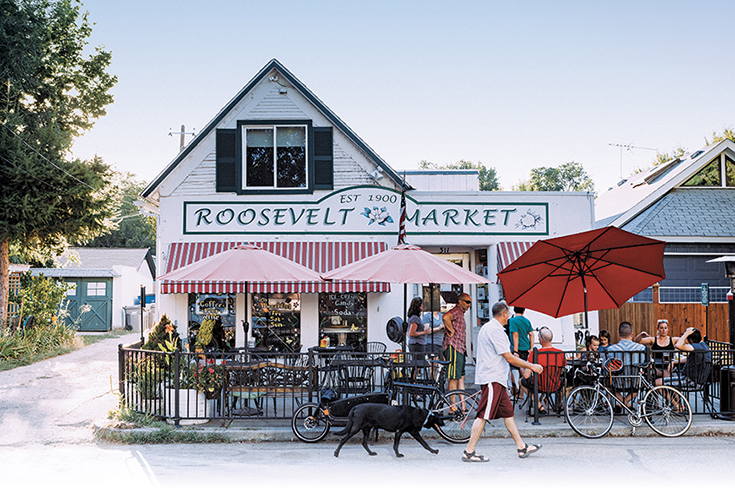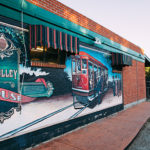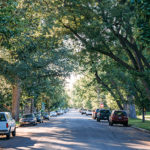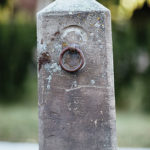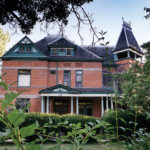Driving down Warm Springs Avenue in Boise is almost an activity in itself, simply for the feeling it evokes in the visitor. There is plenty of shade under towering, mature trees, and every house dotted along the block is uniquely structured but carries familiar, nostalgic qualities from a bygone era, like roomy porches flanked by powder-white Tuscan columns, red brick and lattice shutters. The homes are somehow aged but well cared for, humble but grand, haunting yet comforting.
One of the first homes on Warm Springs Avenue was owned by George Whitfield Russell and still stands today, according to the East End Neighborhood Association. Russell brought pine lumber from Bogus Basin by ox to build the home in 1869 and raised cattle and horses with his family on land filled with apple trees. Early settlers were drawn to this area of town for its flat ground, rich soil, and because the Boise River is close by.
Along with private residences, public buildings were also constructed during the 1870s, including a quartermaster’s building, an assay office to test the purity of minerals that were being mined in Idaho City and other nearby areas, and the Idaho State Penitentiary. The Assay Office is now used for the Idaho State Historic Preservation agency and the Archaeological Survey of Idaho.
The street’s namesake stemmed from a hot springs on the far side of Table Rock, the mountainside visible from the street, but the hot water in the ground would soon be used for more than a resort destination. One Christmas Eve, in 1890, local banker C.W. Moore and other businessmen drilled for hot water in an area near the Penitentiary. They found warm water about 80 feet down, but by the next year, they had drilled 400 feet with two wells that were reaching water at a temperature of 180 degrees. Moore built a mansion that is still standing today on the corner of Warm Springs and Walnut Street, and it became the first home in the United States to be heated by geothermal water.
Most of the historic homes in the Warm Springs neighborhood were built between 1870 and 1940 and span many decades of architectural styles, including Old Colonial, Mission Revival, Queen Anne, Tudor, ranch and bungalow styles. As the area grew, more features developed, some of which are still in use today. Should you decide to visit the historic neighborhood, here are some highlights to consider.
Spy the Horse and Buggy Life
It’s true, horses and carriages once filled the streets of Boise, especially before the advent of paved roads in the 1890s. Some homes still have hitching posts, which are concrete pillars along the sidewalk that were once used to tether wagons and horses to an iron ring at the top of the pillar. There is also at least one mounting block that remains in the “neigh”borhood if you keep your eyes peeled.
Take a Spooky Tour
The Old Idaho Penitentiary housed inmates from 1872 until 1974, and it is now only used for historical tours and various events. Throughout September and October, paranormal investigations and haunted house events are held, complete with beer and wine on the Frightened Felons adult night. A Michael Jackson tribute might even spontaneously break out in the courtyard. The events list can be found at http://history.idaho.gov/old-idaho-penitentiary-events.
Smell the Roses
The Idaho Botanical Garden was established as a private nonprofit corporation in 1984 on 42 acres of old prison grounds next to the Idaho State Penitentiary, about 10 years after the Pen stopped being a functional prison. The outer edges of the garden extend into the Boise foothills, and the sprawling grounds feature 15 acres of roses, irises, native plants and other collections of flowers and bushes. It is accessible to the community year-round and is host to many concerts throughout the summer. Every fall, a harvest festival takes place at the garden, with live music, pumpkin painting, and more. If you’re planning far ahead, check out the garden when it lights up in spectacular fashion for the Christmas season Winter Garden aGlow event.
Enjoy a Generous Portion
Boise used to have a streetcar transit system, or a trolley, but it went bankrupt in the 1920s. A restaurant named the Avenue Inn was established at the end of the trolley line, and it was known for its “generous portions and good food.” By 1976, a new family took over the restaurant and named it The Trolley House. Whether you are hungry for breakfast or lunch, the diner is open seven days a week from 7 a.m. to 3 p.m. The restaurant is also on the National Register of Historic Places.
Swing but Avoid the River
The Warm Springs Golf Course is a popular 18-hole championship course on the banks of the Boise River. It is shaded by large trees and sits right at the bottom of the foothills, so it has some killer views. It is open to the public from sunrise to sunset, every day, year-round. Annual passes can be purchased. The course also has food available at the café.
- The Trolley House
- North Bannock Street
- A hitching post
- C.W. Moore’s 1891 Victorian home.

